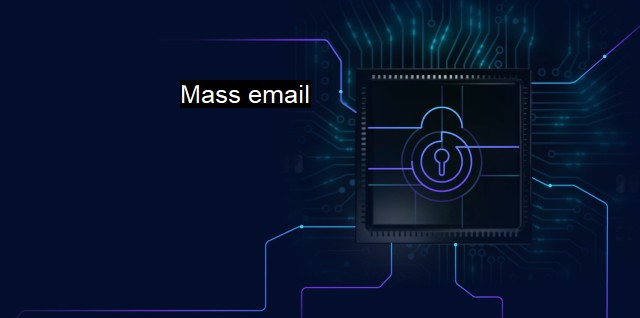What is Mass email?
Exploring the Dangers of Mass Email and Cybersecurity: The Threats of Spam, Phishing, and Botnets on Personal and Corporate Data
Mass email, also known as bulk email, is the process of sending a single message or similar messages to a large group of recipients simultaneously. Mass emails can contain promotional content, advertisements, newsletters, notifications, campaigns about product updates or certain business information. They are often dispatched using a specific form of technology, commonly known as "mass email software" which can effectively handle larger email volumes.In the context of cybersecurity and antivirus defenses, understanding the possible impacts of mass email is a necessity due to its varied use, from organizational governance to masterminding cyberattacks via phishing, spamming, or spreading malware. The same technology helping companies conduct legitimate business communication can be manipulated by cybercriminals seeking to access confidential corporate data for identity fraud, online scams, or other fraudulent activities.
A real-life scenario capturing the harm embedded in mass emails involves phishing emails. Cyber attackers turn mass emails into phishing trips with the hope of capturing those ignorant of the network's integrity obligations. Phishing triggers a psychological response from recipients coaxing them to follow through with the given action points. This exposes official systems, putting sensitive organizational data at the risk of being manipulated, stolen, or corrupted.
Spam emails usually suffice to scale this assault for cybercriminals. These are randomly and massively dispatched emails generally arising unsolicited. While the average volume remains singularly a nuisance, a substantive proportion makes it possible to run extensive frauds reaching around the globe only with the click of a button. Grievously victims can be led to harbor it into their cloud storage, potentially making it an accomplice in a botnet operation or DDoS attack, sparking extreme disruption especially in unprepared sectors.
There is the threat of malware, where mass emails may purposively encase harmful programs designed to penetrate devices impossible otherwise to drop by. Ransomware, spyware, worms, viruses, and trojans are some such examples which can cause catastrophic losses if left unattended. Being contaminations, they derive their name from the malevolent capacity of wreaking havoc on the targeted hosts' digital assets beyond repair, sometimes permanently immobilizing complete infrastructural functionality.
Despite these threats, there are measures one can adopt to ensure safe emailing practices. The basics involve filtering or blacklisting suspicious emails, avoiding clicking on unverified links, and not downloading email attachments from unfamiliar sources.
For businesses, using reliable third-party mailing sources, setting strong firewall protocols, consistently monitoring and reporting spams, establishing antivirus system settings, upgrading operating systems, and applying computer updates without delay are recommendations provided by cybersecurity experts to limit exposure to mass email cyber threats.
Another critical strategy is employee training and awareness programs. Most mass email attacks are successful because the attacker craftily takes advantage of certain naive employees or digitally unaware people who are susceptible to manipulation. A well-trained cyber workforce can successfully mitigate these risks.
End-to-end encryption on email servers can also be useful in this regard. Encryption converts the emails into a secretive code that would help protect the content from unwanted access by unauthorized persons.
Mass email operates as a double-edged sword in that the same opportunities created are those equally exploited to engage greater crime. There is an urgent need for aligning current mass email practices with malicious behavioral preventive measures to build up our cyber resilience. As mass emails continue to beacon a clear mode of spreading cyber threats globally, reinforcing email security measures remains the first step in defending computer systems from cyber threats and attacks.

Mass email FAQs
What is a mass email?
A mass email is a message sent to a large number of recipients at once. It is usually used for marketing, promotional or informational purposes.How does mass email pose a threat to cybersecurity?
Mass email can be used by cybercriminals to deliver malware, phishing scams, and other malicious content. These emails often appear to be from a trusted source, making it easy for recipients to fall for the scam and inadvertently compromise their cybersecurity.How can antivirus software protect against mass email threats?
Antivirus software can scan incoming emails for viruses, malware, and other threats, and block or quarantine any suspicious messages or attachments. By regularly updating their antivirus software, users can stay protected against the latest email-based threats.What are some best practices for sending mass emails that protect against cybersecurity risks?
To protect against cybersecurity risks when sending mass emails, it is important to use a reputable email marketing service with strong security measures in place. Avoid sending messages with suspicious or misleading subject lines, and make sure to include clear instructions for how recipients can opt out of future emails. Additionally, always ensure that any links or attachments included in the email are legitimate and safe.| | A | | | B | | | C | | | D | | | E | | | F | | | G | | | H | | | I | | | J | | | K | | | L | | | M | |
| | N | | | O | | | P | | | Q | | | R | | | S | | | T | | | U | | | V | | | W | | | X | | | Y | | | Z | |
| | 1 | | | 2 | | | 3 | | | 4 | | | 7 | | | 8 | | |||||||